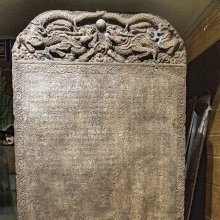Perfume: 3 definitions
Introduction:
Perfume means something in Hinduism, Sanskrit. If you want to know the exact meaning, history, etymology or English translation of this term then check out the descriptions on this page. Add your comment or reference to a book if you want to contribute to this summary article.
Images (photo gallery)
In Hinduism
Shaktism (Shakta philosophy)
Source: Brill: Śaivism and the Tantric Traditions (shaktism)Worship of Perfume formed a part of the Navarātra Tantric ritual (an autumnal festival of the warrior goddess Caṇḍikā).—Worship of weapons with flowers, perfume and food, adapted from the pre-existing Vedic model of military festivities.—Various 5th century sources refer to rituals such as the worship of perfume, for example: Viṣṇudharmottarapurāṇa 2.158.6cd–7, Agnipurāṇa 267.13cd–16ab (repeating Viṣṇudharmottara); Varāhapurāṇa cited in the Kṛtyaratnākara, pp. 364–365.

Shakta (शाक्त, śākta) or Shaktism (śāktism) represents a tradition of Hinduism where the Goddess (Devi) is revered and worshipped. Shakta literature includes a range of scriptures, including various Agamas and Tantras, although its roots may be traced back to the Vedas.
Purana and Itihasa (epic history)
Source: Shodhganga: Elements of Art and Architecture in the Trtiyakhanda of the VisnudharmottarapuranaPerfumes (in Sanskrit: Gandha) were traditionally crafted and applied by professional artisans, as part of the “sixty four kinds of Art”, according to the Kamasutra of Vatsyayana.—Cf. the Sanskrit Gandhayukti.—Indian tradition, basically includes sixty four Art forms are acknowledged. The history of Indian Art covers approximately five thousand years which presents a rich and almost continuous record. The references of sixty four kinds of Kala (कला, kalā) are found in the Bhagavatapurana, Shaiva-Tantras, Kamasutra of Vatsyayana etc.

The Purana (पुराण, purāṇas) refers to Sanskrit literature preserving ancient India’s vast cultural history, including historical legends, religious ceremonies, various arts and sciences. The eighteen mahapuranas total over 400,000 shlokas (metrical couplets) and date to at least several centuries BCE.
Natyashastra (theatrics and dramaturgy)
Source: Shodhganga: Elements of Art and Architecture in the Trtiyakhanda of the Visnudharmottarapurana (natya)Perfume is associated with Kapittha-hasta: one of the twenty-two Single-hand Gestures (in Indian Dramas) (known as asaṃyuktahastas), according to the Viṣṇudharmottarapurāṇa, an ancient Sanskrit text which (being encyclopedic in nature) deals with a variety of cultural topics such as arts, architecture, music, grammar and astronomy.—In the Śabdakalpadruma, the word kapittha is explained as a kind of tree where kapi i.e., monkey comes due to the greed of fruit. The word kapittha again denotes the fruit called wood apple. [...] Apart from holding a garland and necklace, the Abhinayadarpaṇa also suggests the use of this posture to show the activities like picking flowers, offering betel leaves, preparing paste, applying perfumes etc.

Natyashastra (नाट्यशास्त्र, nāṭyaśāstra) refers to both the ancient Indian tradition (shastra) of performing arts, (natya—theatrics, drama, dance, music), as well as the name of a Sanskrit work dealing with these subjects. It also teaches the rules for composing Dramatic plays (nataka), construction and performance of Theater, and Poetic works (kavya).
See also (Relevant definitions)
Starts with: Perfumed, Perfumed bdellium, Perfumer.
Full-text (+1173): Gandha, Ucchadana, Itkila, Sugandhi, Curnamushti, Javadi, Kakkola, Gandhakuti, Koraka, Amoda, Ashvakhura, Hattavilasini, Jhallika, Sarvagandha, Yakshadhupa, Vilepana, Upagandha, Kritrimadhupaka, Kapotacarana, Bhutagandha.
Relevant text
Search found 187 books and stories containing Perfume; (plurals include: Perfumes). You can also click to the full overview containing English textual excerpts. Below are direct links for the most relevant articles:
Cosmetics, Costumes and Ornaments in Ancient India (by Remadevi. O.)
2.12. Pharmaceutical use of Perfumes < [Chapter 1 - Cosmetics]
8. Cosmetics for Worship < [Chapter 1 - Cosmetics]
10. Business and Trade of Cosmetics < [Chapter 1 - Cosmetics]
Amarakoshodghatana of Kshirasvamin (study) (by A. Yamuna Devi)
Daily Life (3): Perfumes < [Chapter 3 - Social Aspects]
Flora (16): Aromatic plants < [Chapter 5 - Aspects of Nature]
Flora (1): Habitat < [Chapter 5 - Aspects of Nature]
Brihat Samhita (by N. Chidambaram Iyer)
Chapter 77 - Preparation of Perfumes (gandhayukti)
Appendix 8 - Glossary of Medical and Botanical terms
Maha Prajnaparamita Sastra (by Gelongma Karma Migme Chödrön)
Appendix 1 - Parable of the perfume of flowers (puṣpagandha) < [Chapter XXI - Discipline or Morality]
Padumapuppha-sutta < [Part 2 - Means of acquiring meditation]
III. Material benefits granted by the Bodhisattva < [Part 2 - Fulfilling the wishes of all beings]
Kamashastra Discourse (Life in Ancient India) (by Nidheesh Kannan B.)
8.3. The Body in Kāmaśāstra < [Chapter 5 - Looking for Alternatives: Possibilities in Kāmaśāstra]
6.8. Livelihood in Ancient India < [Chapter 5 - Looking for Alternatives: Possibilities in Kāmaśāstra]
7.1. The Sixty-four Fine Arts < [Chapter 5 - Looking for Alternatives: Possibilities in Kāmaśāstra]
Dhammapada (Illustrated) (by Ven. Weagoda Sarada Maha Thero)
Verse 54-55 - The Story of the Question Raised by the Venerable Ānanda < [Chapter 4 - Puppha Vagga (Flowers)]
Verse 94 - The Story of Venerable Mahākaccāyana < [Chapter 7 - Arahanta Vagga (The Saints)]
Verse 288-289 - The Story of Paṭācārā < [Chapter 20 - Magga Vagga (The Path)]
Related products
(+32 more products available)







